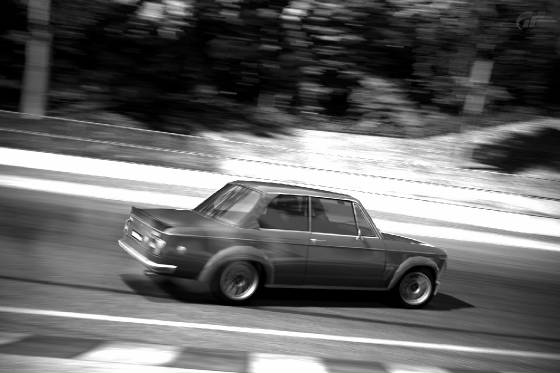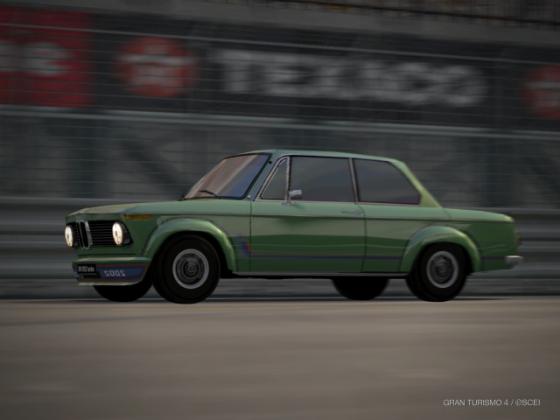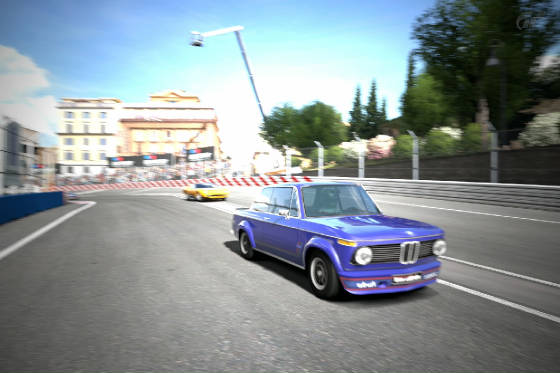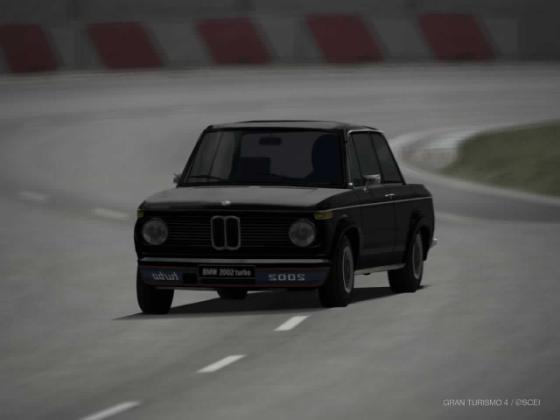|

-------------EXTERIOR / HISTORY----------------
A lot has been written at this site about the early '70s, a time of serious change in the world
of automotive history. During this era, giant muscle cars would eventually be left behind as more and
more Americans desired machines which were practical.
American government also interfered with America's most prolific period of cars that were made to go
fast. Japanese manufacturers were about to start their worldwide dominance by showing the way with smaller designs.
European cars had long been known to be the best choice for those who desired some sort of quality, (even though reliability
may not have always been key) yet many British, German, Italian, and French cars were also economical, smaller,
and practical. America is mentioned often here because American society depended most heavily on cars when compared
to other nations, back then and even now. America's cars used to be tops. Good-looking, powerful, monumental, or at least
something to aspire towards if one had about $4,000 to spend on an automobile, but eventually imports
from Japan and Europe toppled vast portions of our dominance. This all began in the early '70s. So lots has been written
here at www.GTCarReviews.com about fast but clumsy muscle cars; as well as sporty, economical, more capable Japanese autos like the Datsun
240Z and Nissan Skyline GT-R. But which production car during this time of change was the absolute best? ...Best
so far as performance went? Not the absolute fastest of the fast, but best in all other departments? Tight
handling ... great maneuverability, better braking, etc. ...all the departments that matter for circuit racing. There
was a book written during this time, published in 1974 called: "Zen and the Art of Motorcycle Maintenance". Perhaps
you've heard of it. This tells the tale of two civilians who ride around on motorcycles. These guys were not part
of a pack of Hell's Angels or Mongols, as some who have never read this book have assumed. Anyways, there were
these two dudes, and they liked traveling via motorcycle across portions of America in their free time. One of these
guys is practical-minded, the other is not. The practical-minded guy loves tinkering on his bike--an old Triumph
which had seen better days. Or maybe it was a Norton. I forget. Anyways, he's good at working on his bike, keeping
it going. The other guy is lazier. He prefers NOT to work on his bike. Matter of fact, he's absolutely afraid of
machinery and doesn't want anything to do with it. This second, lazier guy has no interest in how things
work. If something goes wrong, take it to the mechanic. And he's riding on a newer state-of-the-art BMW. The
BMW had more power than the other guy's ride. It was also more expensive, and rarely gave any problems while traveling
great distances on the road. However, if a problem did arise, this BMW guy was powerless and terrified to dig
in. Whereas the guy on the Triumph (or Norton, or whatever) had to constantly work on his bike to keep it going.
The BMW-rider thought he was in a better position than the Triumph-rider, simply because his bike was superior. The "Zen"
angle fits in as philosophical points get added to the story. "Which line of thought has a greater bearing on proper
ways of living?" (my words) is a question that eventually gets thrown around. Is it better to know what
the hell you're doing? Or is it better NOT to know, simply because we live in this modern era, in which we
don't have to know everything? Even if your passion is to ride motorcycles for miles and miles, is it proper
to ignore or fear that which gives one so much pleasure? It's an interesting book, full of matchbox-philosophy
thinking like this, and now here I am.... getting too philosophical, instead of spewing out this car review. :-/
Anyways. I bring all this up to illustrate how technologically advanced many people felt BMWs were.
Even way back in 1973, people knew of BMW's reputation for good, strong parts, top metallurgy, reliability, speed, and
also street & track prowess. It is my opinion that the BMW 2002 perhaps was the best one could
buy in 1973, if they were interested in something which had top performance. Let's look at the Japanese. Nissan emulated
the 2002 when they started the C10 generation of their boxy Skyline. They weren't interested in copying the latest
Barracuda or Camaro, instead they turned their attention towards Europe...and the best performance-car Europe had
to offer. ....Okay, second best. Arguably, the Porsche 911 was actually more of a racing car for street use,
although this depends. The Porsche's rear-engine / rear-drive layout was not as driver-friendly as the BMW's front-engine
/ rear-drive layout. ...And well actually...it can be further argued that various Italian supercars (Ferraris,
Lambos, DeTomasos, Maseratis) were actually the BEST performance vehicles on the planet (as they arguably still are now),
but none of these machines were as accessible as the BMW 2002, which means it was much easier for a driver to afford
a 2002 than any of those supercars. An amazing 861,940 2002s were made from 1968
to 1976. Just 1,670 of these 2002s were Turbos. America may not have taken much notice, as many of us were still buying huge,
fuel-gobbling mastodons, but it is documented that Japan certainly did; hence the first generation of the Skyline GT-R is
a boxy car with short overhangs, mechanical fuel-injection, and a tight, spiffy driving quality. BMW made several
variations of the 2002 (besides the Turbo), so it seems the Turbo was mostly a specialty version of their bread-and-butter
2002 models. Anyways, the 1973 2002 Turbo was to be BMW's first production turbocharged automobile. Over
the next few decades, BMW oddly chose not to turbocharge most of their models, making these 2002s rare collector items. For
this reason, it is entirely appropriate that in GT4, we have to win this car, rather than just buying it at any time
we wish. And in GT5 the 2002 Turbo appears in this game's used car lot, which is cramped for both time and space. If you want
a 2002 Turbo, you don't win it; instead you'll have to hunt for it. But, this is a car worth aspiring for,
eh? If you doubt me, do a search if you will. There's plenty to learn about the BMW 2002's dominance
in racing if you're curious (besides, I'm too lazy to get into writing all about it at the moment). Even today, the 2002 is
still often chosen for historic racing of all kinds. In 1973, this car's style looked odd and boxy,
not really sleek at all as modern Beemers are. It's as though Stuttgart designed the 2002 out of a bathtub,
perhaps. In contrast to this, the front spoiler is painted with dual-color neon stripes, a shocking design that jives
with the rest of the bodywork. Well, if this is any explanation, it was the '70s. But also notice the
front-end, with its short overhang. Rather than weigh down the front with a huge motor and massively long fenders, BMW chose
to keep this car's engine small...its body work short & simple. Now notice the rear-end, which has a longer
overhang. "Overhang" means body & chassis material that lies in front of or behind a car's axles, by the
way. "Wheelbase" is anything between these axles. Anyways, the rear trunk area of the 2002 is longer, more spacious than
the front, and offers some natural ballast. So instead of a car with a heavy nose and light tail (as most muscle
cars from the time were cursed with), what we've got is a very balanced design...a design that creates
interesting handling traits that are relatively easy to work with, even for modern GT racing. At just 2,380
pounds to start, the 2002 won't need any weight removed at all for most easy or intermediate races. Matter
of fact, removing weight might just ruin this car's stability. I have yet to lighten a 2002 in GT4, so I have no specs
to share with you all here. But in GT5 one can get all the way down to 2,023 pounds with glass replacement and
all three weight reduction packages. Sucks we can't make it to 2,002. ;)

-------------ENGINE / DRIVETRAIN-------------
Nowadays, we are all familiar with BMW's strong, torquey, high-revving straight-6 engines, which
possess both power and flexibility, and seem damn-near perfect in lots of ways. BMW has also recently crossed the line
from straight-6 to V8. Some of their cars in these last few years bear these larger V8 powerplants.
There are also a few V12s destined for those with the healthiest of bank accounts. Well, this wasn't always so.
Some
may be disappointed with the 2002 Turbo, which sports just a 2.0 liter inline-4 motor. "What's all the fuss about this
wimp?" these clueless dweebs may ask.
Certainly, when compared with most American muscle from the early
70s, the 2002's small engine is a weakling...can't lie about that. With just 168 horses and 177 foot-pounds to
start with, I hate to say the engine is the worst part of this car, but in a way it is. Not that it's a bad
engine... But still. Can't ignore the fact that acceleration starts off below-average, and the 2002 can "only" just
over 130 mph when stock. But to say the engine sucks and so therefore the car also sucks is a huge mistake,
folks.
Fortunately, there are plenty of upgrades to be had. Intercoolers can be bought in GT4, and
the three turbo systems that can be had in either game boast significant power-ups. The three turbos I
expected...the intercoolers I did not. Anyways, with peak performance, we're talking of a randy 362 bhp
and 328 foot-pounds available in GT4 at max. Sure, some modern BMWs can make this much (or more)
even while they're stock, but do they weigh just 2,380 pounds or less? Huh? No way.
The 2002 motor was equipped
with a KKK BLD light-duty turbo while stock. Regular 2002 models had carbureted engines, but the 2002 Turbo featured
fuel-injection, an oil cooler (fully necessary), and generally larger and/or refined parts. All this shows the dedication
BMW had towards making their first turbocharged production car a success. I was a tad shocked about the transmission,
however. Even tho the 2002 is from 1973, I expected a 5-speed instead of a 4. Japanese performance cars from this
era had opted for 5-speeds, for instance. Why just a 4 in the 2002? Not that it matters much; I haven't truely found
a situation yet in which I've needed an extra gear via full-custom gearing, yet... although realistically such
a situation certainly could exist.
The worst thing about these gears is that they are a bit tall...even with
greater power. A Stage 2 or 3 system, for instance, introduces some turbo-lag that wouldn't get noticed if
this car had a 5-speed, because we'll occasionally need to dip below 3,500 rpms in 3rd gear if the car has stock
gearing. Below 3,500 is turbo-lag country for this small motor. This doesn't fully ruin the BMW 2002 experience
in my opinion, but it is something to be aware of. Notice that while stock or with a Stage 1 system, torque & power
show nearly equal numbers in the Home Garage, and once we equip a Stage 2 or 3, horsepower rises while torque lags behind.
Stock
engine with port & polish, balancing, and "computer":
GT4
GT5
196 bhp / 203 foot-pounds 237 hp / 227 ft. lbs.
Full
Stage 1 turbo system:
271 bhp / 273 foot-pounds 313 hp
/ 305 ft. lbs.
Full Stage 2 turbo system:
324 bhp / 309 foot-pounds
339 hp / 341 ft. lbs.
Full Stage 3 turbo system:
362 bhp / 328 foot-pounds
355 hp / 294 ft. lbs.
One of the better things to notice is that this car does not absolutely need
a limited-slip while its power is stock or nearly-stock. Like a Nissan 240Z, the BMW 2002 Turbo is flexible and highly
manueverable. Unlike the 240Z, it manages to put its power down with less fuss....less early wheelspin; and
in some situations a limited-slip can kill this car's gymnastic nature; adding unnecessary understeer.
Also, let's
notice the tires on this car, which are mounted on rather small 13" wheels. In 1973, this must have been partially where
the 2002 got at least some of its track prowess. I'm no expert here, but I'm guessing these smaller tires weren't
prone to much of the flexing and goofy behavior larger tires of the times could have caused, keeping the 2002 on a firm
set of shoes. Nowadays, we're all familiar with super-low profile tires designed for tracks; back in 1973 this technology
wasn't present yet. So it's my opinion (which I can't fully prove, unfortunately) that for tighter handling, BMW kept
smaller wheels & tires on both their normal 2002s and the Turbo.
Speaking of handling...

--------------CHASSIS / HANDLING---------------
Have you ever seen a garbage truck in action? Of course you have. You wouldn't want to race one (well, maybe
you would...) but clearly it has a purpose and it does it well: lifting giant bins of trash, carrying this trash
somewhere else, and dumping it. The garbage truck does its job to 100% of its capacity, assuming everything is working right.
That's how the BMW 2002 is. It may not be able to haul much of a heaping pile of filth, but that's
not what its purpose is. Its purpose is to CORNER, and to do so well.
GT4
There's not much to say in this chapter, other
than the fact that I'm very pleased. This car does everything I want it to do, and even puts some modern-day GTs to shame
at times. Control is really what set this car apart from many others of its time, even other so-called
"sports cars" from the '60s and '70s found in GT4. I recently watched the Newfoundland Targa Rally on the Speed channel, matter
of fact, in which a 1969 BMW 2002 (non-turbo) and a '72 or '73 BMW Bavaria led the way thru stage after stage... beating a
Mitsubishi Evo X, new Dodge Challenger and several other cars 40 years younger. The 2002 likes to make sure
you are in control. Other classic cars from our game may value quarter-mile times, drag racing, noise, smoke,
gruesome looks, but the 2002 is clearly a machine designed with a different purpose in mind.
There is
a huge variety of handling & capability with this machine. Typical GT4 understeer is well-balanced with other traits
more desireable: light rear-end swaying (from that extended trunk area) actually helps one get this car around many
turns via light oversteering motions. There isn't much power at first, but when there is, throttle-steer can melt into
some delicious traction-breaking moments.
GT5
In
this game, I picked a 2002 Turbo to do the FR Challenge, and then tuned it further to see if it could compete in the
Amateur-level Supercar Nostalgia Cup. This series of 3-lap races includes Rome, Suzuka's full circuit, and
Laguna Seca, plenty of opportunity to drive and get to know this machine. I am not sure if it is
possible the 2002 can survive this set of races, since it could only make 362 hp in GT4. A 2,500 pound car requires at least
390 at Rome, which means I'm going to finally be lightening this auto as I power it fully.
First thing that's noticed
at Suzuka (after making a wrong turn) is how easy it is to smoke this car's rear tires from a standstill. With just 174 horses,
one can do a burnout! Then I started driving the rest of the course. Another item of interest is the fact that this
car's stock tires are soft radials (comforts), and I was shocked to see the fronts overheating in some of Suzuka's twisty
turns. This car actually has more limits than it did in GT4, then.
The front-end (steering) feels easy to point, but
the rear is now a different story. It feels more difficult to manage than it did in 4. Even with just 174 horses, the rear-end
can sway drastically from side to side if too much power gets planted down too fast. Countersteering is now a common way to
combat this action (very unlike GT4), and braking is also more difficult, since ABS can be turned off.
So far
as braking goes (heh heh...) the BMW is one of the best I've driven with a non-ABS system. Assuming the driver
misses a braking point, and the turn we're approaching is not a super-fast one, damage control can be applied with less
consequences. As the car sways this way and that like a dory in a storm, feathering the brakes while carefully finding the
best racing line is still a BMW hallmark.
Overall, the car still has its flavor. Even on cheap tires,
it can eventually be flung into turns, once the driver gets more confidence! It can eventually be skittered about this
way and that. The main difference between GT4 and GT5 is the latter game takes more concentration to implement such moves
(sliding and drifting, etc.). And for those who choose to simply grip in and out of turns, the BMW is not as helpful as it
was. Some tuning (and/or very careful driving) is definitely in our future. Not so much for Beginner-league races,
but certainly for the harder stuff.
Sport tires make a huge difference, especially on the rear. A lot of the fishtailing
behavior gets diminished with some sports. Limited-slip tuning, however, seems still more of an option than a necessity, until
we are needing to tune this Beemer to its max for some advanced racing. But for easier events, LSD not 100% necessary. Think
of LSD in GT5 as a spice you might put on your eggs. The eggs taste good even without the spice, but using that spice will
make the eggs even more enjoyable to eat. That's the way tuning a 2002 Turbo is: it's good while it's stock, but we can't
really approach its best traits until some limited-slip tuning is involved.
And now... here are my impressions of
this car during the Nostagia Cup.
Rome
With the 2002 lightened to its full Stage 3 (2,023) but then ballasted
back to 2,100, it was not as stable, especially over rumble strips. I messed with ballast position (slightly rearward), limited-slip
settings, suspension and transmission settings until I somehow got the car handling damn-near perfect.
I had a height-adjustable suspension; I am certain that in GT4 it could probably go stock!
Fully-powered
(355 hp), the 2002 would often understeer lightly into turns, and then I could transition from braking to acceleration with
occasional slipping from the rear. Overall, the Beemer felt positively better than it did, had tuning not been attempted.
...ahem...
Suzuka Circuit
Now things are much different. With Suzuka's long list of winding esses and flat-run
curves, the BMW still felt awesome going into turns ( assuming I kept strict about braking zones) but terrible leaving
them. Damage control becomes much more pertinent. We might need to consult our damage control expertise at any time
during this difficult track! I am not an expert tuner, folks. I messed around with limited-slip and suspension settings
a bit, but could only get things marginally better. Be warned: this car is not for intermediate drivers anymore. Not without
cheating on racing slicks, that is.
But the Beemer survived Suzuka intact, after two or three tries
(with two different grids of competition). Throttle control becomes much more necessary at this track. Often, anything
more than half-throttle during a curve is death, while the Lamborghinis can use full-throttle backed up with traction-control.
I never thought I'd spin a 2002 Turbo in Gran Turimso. Well, I just did!
One final note: I noticed out of this
track's tightest hairpin I could use either 2nd or 3rd gear. 2nd had to be planted down carefully, and resulted in some unwanted
wheelspin if the Beemer was leaving on just a hair too much of an angle. But with 3rd gear, the engine now bogged down with
turbo lag. Yes, it is slower this way, but I could use all of this engine's available power, with zero fear of wheelspin
from the rear. And then once the lag ended, the engine zinged with its usual turbo power.
Laguna Seca
Elevation
changes come into play here; the other two tracks are relatively flat in comparison. The competition tends to drive Laguna
Seca with less ferocity, though, which means my Stage 3 powered car was now using Stage 2 power.
The BMW
was raised a bit, its gears made closer. Maybe it's me, but I found the car easiest to drive at this track. Cars can often
be passed on the outside here, as they struggle to figure out how to drive this course, and the 2002 Turbo rises to
the occasion with ease. I experienced more understeer at Laguna Seca, but this could be just a combination of driving style
and tuning. The car is still difficult, but felt most confident here ... at this track with mostly lower-speed turns.
Summary
At
all times, the squat 2002 feels ready to annihilate whatever handling dilemma there is to be faced. Modern
BMWs are much hyped for their cornering prowess; most of this hype is actually well-desereved. But it's also notable that
this prowess is nothing new. Back in 1973, BMW was already attempting to make the 2002 one of the best.
PROS----------------------------------------
1). Read the entire
last (Handling) section!
2). Yet another classic to pine after. BMW doesn't offer any others from the '70s or '80s,
sadly. The 2002 is almost mandatory when mentioning famous sports cars from the '70s.
3). Three
levels of intercooled turbo in GT4...all of them worth their credits. Intercoolers are not in GT5, of course, but we can still
get many miles per credit value in this game.
4). A great rear-drive car for on and off-road driving. Endurance
racing, sprint cups, etc.
5). The exhaust/engine soundbyte doesn't sound like yet another Miata sample.
6).
One of the best drifting cars of GT4, all that's needed is some additional power and better gears. N tires or S1 tires
work best. GT5's car can be drifted while entirely stock by even the noobiest of noobs, and offers more possibilities while
doing so.
CONS--------------------------------------------
1).
Goofy looks, especially the multi-color spoiler. Almost as bad as a "Le Car" Renault 5! I don't mind, but some may cry
"fugly!"
2). A 4-speed transmission, even tho by 1973, 5-speeds were becoming all the rage.
3). Lackluster acceleration.
With upgrades, turbo lag starts to develop, making acceleration tricky at times.
4). "Just" 362 horsepower at best
in GT4.
5). We have to win this car. Some may never figure out how & where till they visit a FAQ site.
6). The 2002 (being a 1973 vehicle) is also exempt from several great Classic Car races, which only allow 1970
vehicles & earlier. This is more a criticism of GT4 itself, than the actual car. GT5 offers more avenues to take a 2002.
7). Boxy aerodynamics limit straight speed.
8). Can't be bought in GT4, must be won. In GT5 it is a rarely-found used car.
9). GT5:
one of those 'Standards' that looks great from a distance, but once we're up close we can see all the flaws. Putty-sculpted
wheel arches. Chrome detailing that looks more like tin foil.
Published:
February 17, 2009
Edited for GT5: November 18, 2012
|







